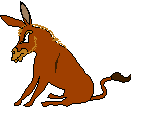Copyright © University of Cambridge. All rights reserved.
'Up and Down Donkey' printed from https://nrich.maths.org/
Show menu
Why play this game?
Up and Down Donkey gives children the chance to become more fluent in counting, in a motivating context. The game is easily adaptable:
- you can offer variations which require some strategic (and therefore higher-order) thinking
and/or
- you can introduce higher-level content (e.g. odds/evens; factors/multiples), so the game supports children's understanding of the structure of our number system.
Carry on playing to give learners chance to reflect on their discussions, and then bring everyone together to clarify how they think they play the game.
Once the group has decided upon the rules and how to win, give pairs of children copies of the cards. Give them time to play several times so that they become immersed in the game. You may like to leave sets of the cards available for the children to use during their own free time or play times.
Set aside some time to talk to the whole group about the game. This might be better done a week or so after first introducing the game when they have had chance to play many times. Invite comments about whether they think it is a good game and why/why not. How could they make it better? At this point you could introduce one of the suggested variations or suggest the children make up their own versions. It might be helpful for some children to have guidance as to how to vary the game. For example, you could specifically ask them to create some different cards. Or you could ask them to suggest a different rule for the centre stacks. It's important that pairs try out their new versions, to check that the game works!
Where could you put that card?
Up and Down Donkey gives children the chance to become more fluent in counting, in a motivating context. The game is easily adaptable:
- you can offer variations which require some strategic (and therefore higher-order) thinking
and/or
- you can introduce higher-level content (e.g. odds/evens; factors/multiples), so the game supports children's understanding of the structure of our number system.
Possible approach
This may be most easily introduced to a small group of children. If possible, begin to play the game against another adult completely in silence, using six sets of the most appropriate cards (1-10DotNumberCards.pdf or 1-10DotNumberCards2.pdf or 1-10DigitNumberCards.pdf or 1-10WordNumberCards.pdf or 1-20NumberCards.pdf). Explain to the group that you'd like them to watch carefully to see whether they can work out how to play. Stop after a suitable number of turns and suggest that the children talk in pairs about the possible rules of the game.Carry on playing to give learners chance to reflect on their discussions, and then bring everyone together to clarify how they think they play the game.
Once the group has decided upon the rules and how to win, give pairs of children copies of the cards. Give them time to play several times so that they become immersed in the game. You may like to leave sets of the cards available for the children to use during their own free time or play times.
Set aside some time to talk to the whole group about the game. This might be better done a week or so after first introducing the game when they have had chance to play many times. Invite comments about whether they think it is a good game and why/why not. How could they make it better? At this point you could introduce one of the suggested variations or suggest the children make up their own versions. It might be helpful for some children to have guidance as to how to vary the game. For example, you could specifically ask them to create some different cards. Or you could ask them to suggest a different rule for the centre stacks. It's important that pairs try out their new versions, to check that the game works!
Key questions
Which number/s do we need next for the centre stack/s?Where could you put that card?
 This game used to be sold commercially so some families may have a box hiding in a cupboard!
This game used to be sold commercially so some families may have a box hiding in a cupboard!